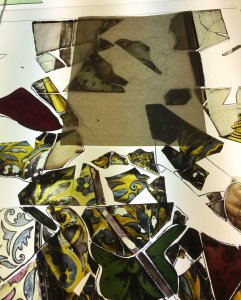Visitors to the Abbey Museum may have noticed a stained glass window that was once above the main door has been removed. I can assure you that this is not permanent but just part of the ongoing conservation program of our stained glass windows. This panel depicts a crowned figure holding a covered cup in one hand and a sceptre in the other. These attributes indicate that it is a king although the identity of the figure was unknown; the catalogue simply records it as “The Donor King” . However, during conservation of the window new evidence has come to light which is very exciting. Research has revealed that it was probably part of a much larger window depicting the three Magi (the Three Wise Men or Kings as they are also known) from the Biblical story of the Nativity of Christ. The window has been badly damaged and conserved a number of times during its history, and sadly the quality of the later work does no justice to the exquisite quality of the original window. Not only is it painted on glass that is less than 2 mm thick but the quality of the painting would rival any of the great master artists of the Renaissance.
Donor King Stained Glass undergoing conservation
The style and quality of the work indicates that the original window is most likely from Germany and dates to about 1525. We now know it depicts Balthazar, the third of the Magi who according to Christian tradition brought myrrh as a gift to the new born baby Jesus. It is interesting to note that up until the 16th century all three “kings” were depicted at white, one young, one middle aged and the other elderly. However at this time a new dimension was added with each representing the major cultural groups and known continents in the world – European, African and Asian.

The clue which revealed the identity of the king is a strange griffin head which on closer examination was identified as the hilt to a sword. What was extremely exciting to our Senior Curator, Michael Strong, was when he discovered a parallel sword hilt in the famous painting of the ‘Adoration of the Magi’ by Hieronymus Bosch, now in the Metropolitan Museum of Art in New York and one of the greatest works by this Renaissance master. This would suggest that the stained glass artist was familiar with the work of Bosch and had been inspired by this fine detail from his painting.

Another detail also confirmed our identification. One of the definitive clues to the identity of Balthasar is the desire of Renaissance and Medieval artists to make him exotic. This is reflected in a piece of costume invariably found in images of the third king. Balthasar wears a large bow to tie across his tunic, usually green or white. This bow was present in our window but because of the poor conservation was mislocated.
The window is due to be reinstalled in late May, ready for the Medieval Festival in July. If you are visiting the Festival take the opportunity to visit the Abbey Museum and see this stunning stained glass window.

